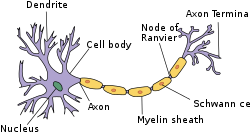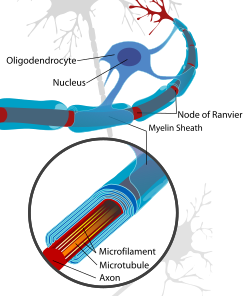Myelin Function and Importance
- Myelin insulates nerve cell axons to increase the speed of electrical impulses.
- It allows electrical charges to jump along the axon, resulting in faster information transmission.
- The myelin sheath reduces the accumulation of electrical charges by increasing the distance between extracellular and intracellular ions.
- Saltatory conduction occurs as the action potential jumps from one node of Ranvier to the next.
- Myelin is essential for efficient motor function, sensory function, and cognition.
- Myelin allows for the transmission of electrical signals between nerve cell bodies.
- The insulating function of myelin is crucial for various functions, such as movement, sensory perception, and acquiring/recalling knowledge.
Myelin Development and Species Distribution
- Myelination begins in the 3rd trimester of human development.
- Rapid myelination occurs during infancy, corresponding to the development of cognitive and motor skills.
- Myelination continues through adolescence and early adulthood.
- Myelin sheaths can be added in grey matter regions throughout life.
- Language comprehension, speech acquisition, crawling, and walking are associated with myelination.
- Myelin is a defining characteristic of jawed vertebrates (gnathostomes).
- Invertebrates have glial wraps that are functionally equivalent to myelin.
- Non-myelinated axons coexist with myelinated axons in the central nervous system (CNS).
- In the peripheral nervous system (PNS), a large proportion of axons are unmyelinated.
- Invertebrates such as oligochaetes, penaeids, palaemonids, and calanoids have myelin-like sheaths.
Myelin Composition
- Myelin in the central nervous system (CNS) and peripheral nervous system (PNS) performs the same insulating function.
- Myelin is rich in lipid, giving it a white appearance.
- Approximately 40% of myelin is water, while the dry mass consists of 60-75% lipid and 15-25% protein.
- Myelin basic protein (MBP) plays a critical role in the formation of compact myelin.
- Proteolipid protein (PLP) is the most abundant protein in CNS myelin, while myelin protein zero (MPZ or P0) is important in the PNS.
Disorders and Clinical Significance
- Disorders affecting myelination include genetically determined leukodystrophies, multiple sclerosis, and inflammatory demyelinating peripheral neuropathies.
- Multiple sclerosis is the best-known disorder of myelin.
- Demyelination is the loss of the myelin sheath and is associated with neurodegenerative autoimmune diseases.
- Demyelination can lead to impaired conduction of signals along the nerves.
- Symptoms of demyelination vary but can include visual disturbances, weakness, cognitive disruption, and fatigue.
- Dysmyelination is characterised by defective structure and function of myelin sheaths.
- Dysmyelination does not produce lesions like demyelination.
- Genetic mutations affecting myelin biosynthesis can cause dysmyelination.
- Repairing damaged myelin sheaths is an ongoing area of research.
Myelin Plasticity and Future Directions in Research
- Myelin has traditionally been considered a static structure, but recent research has shown that it is dynamic and can undergo remodeling.
- Experience-dependent oligodendrogenesis allows for myelin remodeling in response to environmental stimuli.
- Myelin plasticity is important for learning, memory, and recovery from injury.
- Advances in imaging techniques, such as magnetic resonance imaging (MRI), allow for the visualization and quantification of myelin in vivo.
- The development of animal models and in vitro systems has facilitated the study of myelin biology and pathology.
- Researchers are exploring novel therapeutic approaches to promote myelin repair and regeneration in demyelinating disorders.
- Biomarkers for myelin-related diseases are being investigated to improve diagnosis and monitoring of disease progression.
- Collaborative efforts are being made to better understand the complex interactions between myelin, neurons, and other glial cells in health and disease.
Myelin is a lipid-rich material that surrounds nerve cell axons (the nervous system's electrical wires) to insulate them and increase the rate at which electrical impulses (called action potentials) pass along the axon. The myelinated axon can be likened to an electrical wire (the axon) with insulating material (myelin) around it. However, unlike the plastic covering on an electrical wire, myelin does not form a single long sheath over the entire length of the axon. Rather, myelin ensheaths the axon segmentally: in general, each axon is encased in multiple long sheaths with short gaps between, called nodes of Ranvier. At the nodes of Ranvier, which are approximately one thousandth of a mm in length, the axon's membrane is bare of myelin.

| Myelin | |
|---|---|
 Structure of simplified neuron in the PNS | |
 Neuron with oligodendrocyte and myelin sheath in the CNS | |
| Details | |
| System | Nervous system |
| Identifiers | |
| FMA | 62977 |
| Anatomical terminology | |
Myelin's best known function is to increase the rate at which information, encoded as electrical charges, passes along the axon's length. Myelin achieves this by eliciting saltatory conduction,. Saltatory conduction refers to the fact that electrical impulses 'jump' along the axon, over long myelin sheaths, from one node of Ranvier to the next. Thus, information is passed around 100 times faster along a myelinated axon than a non-myelinated one.
At the molecular level, the myelin sheath increases the distance between extracellular and intracellular ions, reducing the accumulation of electrical charges. The discontinuous structure of the myelin sheath results in the action potential "jumping" from one node of Ranvier over a long (c. 0.1 mm – >1 mm, or 100-1000 micron) myelinated stretch of the axon called the internodal segment or "internode", before "recharging" at the next node of Ranvier. This 'jumping' continues until the action potential reaches the axon terminal. Once there, the electrical signal provokes the release of chemical neurotransmitters across the synapse, which bind to receptors on the post-synaptic cell (e.g. another neuron, myocyte or secretory cell).
Myelin is made by glial cells, which are non-neuronal cells that provide nutritional and homeostatic support to the axons. This is because axons, being elongated structures, are too far from the soma to be supported by the neurons themselves. In the central nervous system (brain, spinal cord and optic nerves), myelination is formed by specialised glial cells called oligodendrocytes, each of which sends out processes (limb-like extensions from the cell body) to myelinate multiple nearby axons; while in the peripheral nervous system, myelin is formed by neurolemmocytes (Schwann cells), which only myelinate a section of one axon. In the CNS, axons carry electrical signals from one nerve cell body to another. The "insulating" function for myelin is essential for efficient motor function (i.e. movement such as walking), sensory function (e.g. sight, hearing, smell, the feeling of touch or pain) and cognition (e.g. acquiring and recalling knowledge), as demonstrated by the consequence of disorders that affect myelination, such as the genetically determined leukodystrophies; the acquired inflammatory demyelinating disorder, multiple sclerosis; and the inflammatory demyelinating peripheral neuropathies. Due to its high prevalence, multiple sclerosis, which specifically affects the central nervous system (brain, spinal cord and optic nerve), is the best known disorder of myelin.